|
|
|
|
|
Intel Pentium D 920 and 955 Extreme Edition |
|
Join the community - in the OCAU Forums!
|
Overclocking
OVERCLOCKING “PRESLER”
All Pentium D CPUs come with a locked multiplier. Overclocking the 920 is therefore done by increasing the FSB frequency and manipulating core, chipset, memory voltages, and the memory divider, for added stability. The Pentium D 820 in our first dual core test gave us air-cooled an additional 700 MHz, roughly 25%. This increase is similar to what is achievable with an air-cooled X2 3800+. The 65m based Pentium D 920 turned out to be of different caliber. Without additional voltage both 920 samples went up to 14 x 260 MHz = 3640 MHz. At that point we had reached the BIOS specified overclocking limit (+30% FSB) with Intel’s 975XBX motherboard. Assuming that the CPU frequency could go higher we switched to the Asus P5WD2-E motherboard. By increasing the core voltage slightly to 1.40 volt and the chipset voltage to 1.65 volt it was possible to boot into Windows XP and run a few benchmarks like SuperPi or SiSoft Sandra at 4300 MHz.
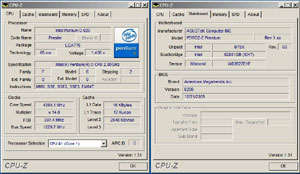
Both 920 were stable running with air-cooling above 4.0 GHz. One 920 sample was stable at 14 x 290 MHz = 4066 MHz, the other one at 4036 MHz. That is around 45% above the 920 default frequency. The memory was running at 1:1 with timings of 3-3-3-8.
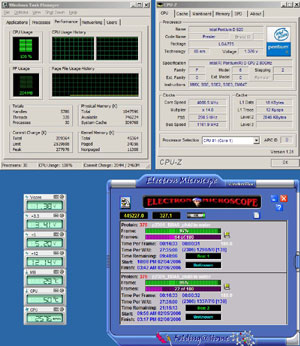
The 955 Extreme Edition comes like the FX-60 with an unlocked multiplier. It's good that AMD and Intel understand that if you spend that much money for a processor, you should have some additional “benefits”. Upping the multiplier can sometimes be helpful to bypassing overclocking bottlenecks because it allows running the FSB with lower frequencies which is reducing stress for system and peripherals. The 955 XE is by default clocked at 13 x 266 MHz = 3460 MHz. We found that the 955 XE sample was overclocking best with a 14x multiplier. It did boot into XP at 14 x 342 MHz = 4800 MHz, and was stable at 14 x 312 MHz = 4.37 GHz. Increasing the chipset voltage gave us with both motherboards (Intel 975XBX and Asus P5WD2-E) better stability, increasing the front- side-bus voltage did not have any impact. We also found that that increasing the core voltage above around 1.40 volt did not have any further positive impact.
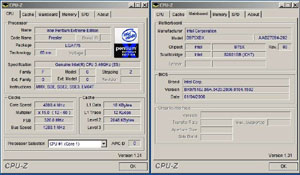
It is obvious, not only by our results but many other user reports, that “Presler” has huge overclocking potential. One report shows a phase-change cooled Pentium D 920 booting into Windows XP at well above 5.0 GHz. Benchmarking a phase-change cooled 920 seems to be possible between 4.7 and 4.8 GHz. Other reports show phase-change cooled 955 XE samples benchmarked at 5.6 GHz. It seems that even better results are achievable with “Cedar Mill”. OCAU members are reporting to have aircooled samples benchmarking-stable running 60% above default frequency. It is clear that the change to 65nm has given the Pentium 4 a new lease on life - until it will be replaced at the end of 2006. The enormous upward frequency potential gained with the change to 65nm looks also very promising in regard of “Conroe” and “Merom” to be released later this year.
The FX-60 is clocked by default at 13 x 200 MHz = 2.60 GHz. Like all other FX products it comes with an unlocked multiplier. We tried various variations of multiplier and FSB/HTT frequencies. At the end we settled for 14 x 207 MHz = 2.90 GHz with the core voltage set to 1.45 volt. Anything higher than that would result in a lack of stability during our 24-hour endurance test. The fact that even with additional voltage “only” around 300 MHz are possible indicates that the AMD’s Toledo core is pretty much maxed out with 90nm technology. The X2 3800+ has become for many enthusiasts the dual core processor of choice because it offers plenty of overclocking headroom and comes for an attractive price. Like all X2 processors its multiplier is locked. The X2 3800+ was stable running the 24-hour FAH test with up to 10 x 256 MHz = 2560 MHz.
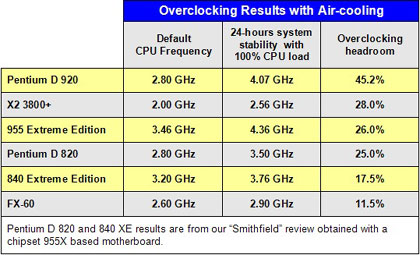
All benchmarks at default frequencies were repeated with the overclocked Intel and AMD systems. The 955 XE and in particular the 920 provide a very substantial performance gain when running up to 45% above default frequency. The impact is not linear and not identical for all applications and games though. The 920 for example is gaining almost 35% in Battlefield, but only 25% in Quake. The rendering time in Photoshop CS2 improved 27%, the compression time with WinRAR by around 20%. Knowing already that both the 920 and 955 XE had better relative overclocking headroom than the X2 3800+ and in particular the FX-60, it did not come as a surprise that the performance ranking between these CPU looked different from the results we had obtained at default frequencies. The 955 XE clocked at 4360 MHz was faster than the FX-60 clocked at 2900 MHz in 6 out of 7 application benchmarks. Only encoding with LAME was done faster with the FX-60. In gaming the overclocked 955 XE was faster in “Call of Duty 2” and Battlefield, and neck-to-neck in Quake 4 and F.E.A.R. The comparison between the overclocked 920 and X2 3800+ looks similar: The 920 running at 4066 MHz was beating the X2 3800+ clocked at 2560 MHz in 6 out of 7 applications, and 2 out of 4 games.
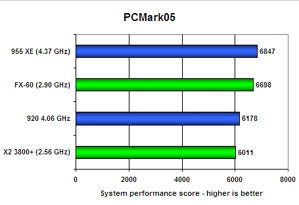 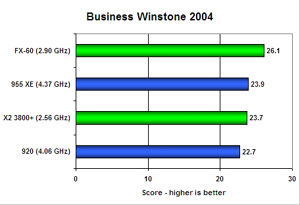
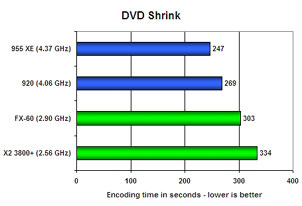 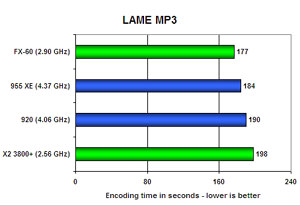
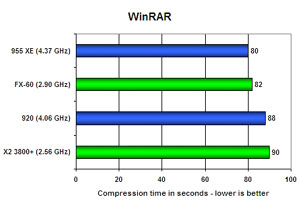 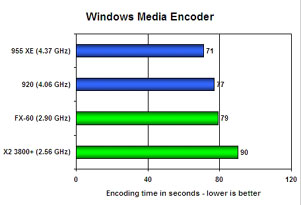
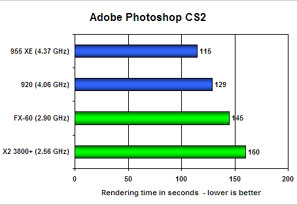 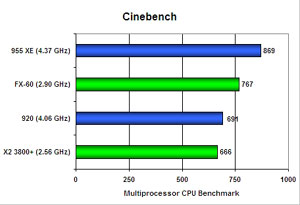
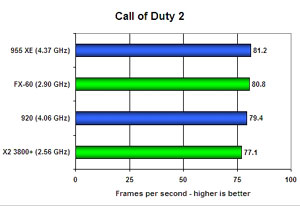 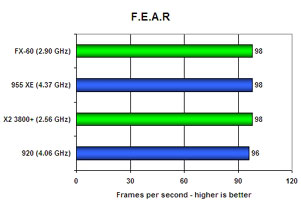
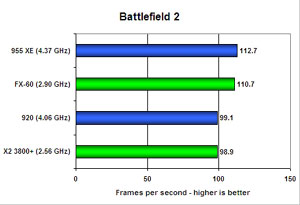 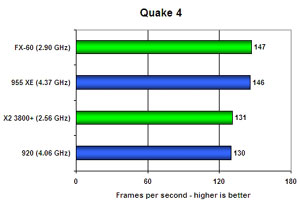
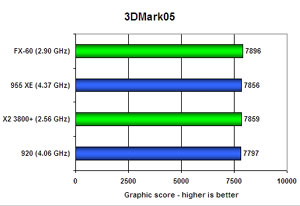
We have to emphasize here that “beating” does not mean that the difference would be actually noticeable for the user. In fact, in none of the tests with the overclocked systems did we “feel” or “see” any difference. We think that it would take at least a 20% lead to produce a noticeable difference for the user.
|
|
Advertisement:
All original content copyright James Rolfe.
All rights reserved. No reproduction allowed without written permission.
Interested in advertising on OCAU? Contact us for info.
|

|


